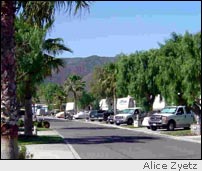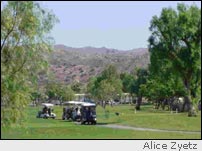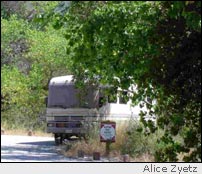| How To Find an RV Campsite, by Alice Zyetz |
|
Memorial Day is past -- it's time to think about your trips this summer. You've decided where you want to go, but where will you park? How do you start looking for a campground? What does it cost? Will it accommodate your size RV? Do you need reservations? What activities are there for your kids?
There are many types of public and private campgrounds throughout the United States and Canada. In a previous column I wrote about the benefits and types of membership campgrounds available in the United States and Canada. There are also various kinds of both non-membership campgrounds and free sites where you can stay overnight while en route, or places where you can boondock (dry camp) for longer periods.
Prices for RV camping sites range from free to $100+ per night. Styles vary from overnight parking, on concrete, in a truck stop to boondocking in a rustic setting, to vacationing in a five-star resort with swimming pools, golf courses, restaurants, and tennis courts. The choice is yours, depending on your purpose and pocketbook. Over the years, I've heard people pontificate that real camping is not even having a tent; but if you must have a tent, you definitely don't have an RV; but if you must have an RV, you definitely only park in undeveloped areas and don't pay any money; but if you do pay money, you definitely don't pay much; and so forth.
As I see it, the essence of the RV lifestyle is that you enjoy whatever is right for you at this time. Here's how to find YOUR special places this summer.
OVERNIGHT PARKING
This is not camping in any sense of the word. Use these sites when en route to your destination. The etiquette is definitely NOT to camp. Don't put out your camp stove, BBQs, laundry, and NEVER, NEVER dump your black or gray water. Many businesses allow truck drivers to stop overnight to sleep in their cabs. Truck stops, many Wal-Marts, KMarts, Interstate rest stops, and restaurants that cater to truckers usually welcome RVers as well.
At a commercial or store site, always ask permission first. Patronize the businesses whenever possible. The advantage is these sites are free. The disadvantage is these sites are free. Everybody else is parked nearby. Invariably, the refrigerated truck (which runs all night) will be next to you.
|
FREE AND INEXPENSIVE CAMPING
Don Wright is one of the pioneers in gathering this information. His guides to free and inexpensive camping (under $12/night) in the West and East are invaluable for those who are on a strict budget. Often the campgrounds are remote and provide the solitude that some campers desire. The sites include many public lands from national forest to local small town city parks as well as regional and local utility company land. Many Bureau of Land Management (BLM) sites are open to public usage for little or no cost. Most United States National Forest Service areas that are not designated campgrounds allow you to park in some open spaces where you are not blocking a road as long as there are no signs prohibiting you.
These sites are usually unimproved lands with no services. You must bring everything with you, including water. You are obligated to leave the land as you find it or better. Carry out all trash, do no dumping, do not run over any plants, and respect the land.
PUBLIC CAMPGROUNDS
Public campgrounds include national parks, national monuments, national forests, parks run by the Army Corps of Engineers, and state, county, and city parks. In Canada, there are national, provincial, and local parks. Generally, there are fewer services and hookups compared to private parks. In the older campgrounds, the sites are smaller and cannot accommodate the newer, larger rigs. Check the guidelines before you go if you have a large rig. The ambience is generally more rustic. Activities are more natural: fishing, boating, hiking. The larger parks have campground programs and activities for children.
In U.S. public parks, average fees are $20 per campsite per night. Discount and park pass cards based on age and/or disability are available and reduce fees at campgrounds managed by the National Park Service, Bureau of Land Management, Corps of Engineers, Fish and Wildlife Service, the U.S. Forest Service, and Tennessee Valley Authority locations. For more information on requirements and current discounts, click here. In many of the publicly-owned parks in both Canada and the United States can be made online at ReserveAmerica.com for an additional fee. No more than 60% of sites in public parks can be reserved -- the rest are on a first-come, first-served basis. For a popular site or a holiday weekend, it's wise to make reservations in advance.
PRIVATE CAMPGROUNDS
Fees at private campgrounds range from $10 to $60+ per night, although parks in some of the mega-theme parks like Disney World can run up to $100 per night. Weekly and monthly rates are also available. The smaller independent parks tend to be mom-and-pop operations. Generally the campgrounds are older, sites are smaller, more casual, less expensive, and offer fewer planned activities. They often have more natural settings.
The larger parks tend to be more corporate-oriented, have larger sites that can accommodate larger rigs, have 50-amp electrical service, more activities for children as well as adults, and are more expensive. The surroundings are well landscaped, and the parking areas for the RVs are concrete. Many feature golf courses, swimming pools, tennis courts, and big clubhouses. Reservations are easy to make within the affiliated system. Membership clubs like Good Sam, AAA, Happy Camper, and others offer discounts at many of these parks.
Kampgrounds of America ("KOA") is a well known camping organization. Some of their parks are corporate-owned and others are franchises, but they all share the corporate philosophy of making the camping family-friendly. To be hired by KOA, an employee must be customer-oriented. Jaimie and I were at a job fair together with KOA leaders, and I have never met a friendlier group of people.
Some privately-owned parks have fairly restrictive rules: Motorhomes only or vehicles that are less than ten years old. A number of the larger RV resorts specifically prohibit vans, pop-ups, truck campers, and Class B Motorhomes. In addition, the minimum length of recreational vehicles at many of these more restrictive RV parks is 26 feet. The advantage of the larger parks is that they are full-scale vacation resorts, particularly useful for families with children. People with bigger rigs know they will have sites that are easy to access and can accommodate their size and electrical needs. A professional staff is always available for technical assistance and recreation. The smaller parks tend to be more informal, personal, and cost less. Families are free to make their own recreation arrangements in the surrounding areas if the RV parks lack a lake or swimming pool. Older and smaller rigs are welcome. Many parks fall in the middle with moderate prices and very acceptable facilities.
One of the best ways to locate and identify RV parks is, as you travel, talk to other campers about their favorites.
See ya down the road! Happy trails!
Alice Zyetz
6/5/05



